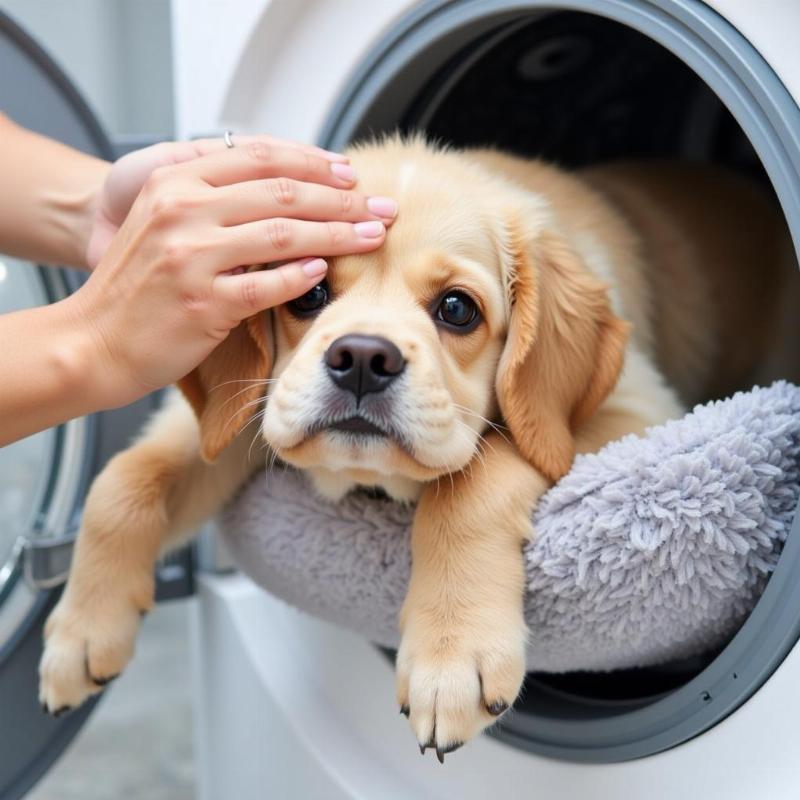Dust mites are a common allergen for humans, but can they also bother our canine companions? While dogs aren’t typically allergic to the mites themselves, they can react to the waste products these microscopic creatures produce. So, how do you know if your dog is suffering from a dust mite allergy? This article will explore the signs, symptoms, and solutions for dealing with dust mite allergies in dogs, offering practical advice for pet owners in the US.
Recognizing Dust Mite Allergy Symptoms in Your Dog
Unlike flea allergies that often manifest as intense itching and visible bites, dust mite allergies in dogs can be more subtle. Your dog might exhibit a range of symptoms, making it tricky to pinpoint the cause. Common signs include:
- Itchy Skin: Persistent scratching, licking, and chewing, particularly around the face, paws, and ears.
- Skin Infections: Secondary bacterial or yeast infections due to constant scratching and compromised skin barrier.
- Hair Loss: Patchy or generalized hair loss due to inflammation and irritation.
- Ear Infections: Chronic ear infections characterized by redness, swelling, discharge, and head shaking.
- Respiratory Issues: Sneezing, coughing, and wheezing, though less common than skin-related symptoms.
“Dust mite allergies often mimic other skin conditions, making accurate diagnosis crucial,” explains Dr. Emily Carter, DVM, a veterinary dermatologist based in Austin, Texas. “Consulting a veterinarian is essential to rule out other potential causes and develop a tailored treatment plan.”
Diagnosing and Treating Dust Mite Allergies
If you suspect your dog has a dust mite allergy, a trip to your veterinarian is the first step. They’ll perform a thorough physical exam and may recommend allergy testing, such as intradermal skin testing or blood tests, to confirm the diagnosis. Once confirmed, treatment options may include:
-
Medications: Antihistamines, corticosteroids, and other medications can help manage itching and inflammation.
-
Immunotherapy: Allergy shots can desensitize your dog to dust mites over time, reducing the severity of allergic reactions.
-
Environmental Management: This is the cornerstone of dust mite allergy control and includes:
- Frequent Cleaning: Regular vacuuming with a HEPA filter vacuum, washing bedding weekly in hot water, and dusting surfaces can significantly reduce dust mite populations.
- Humidity Control: Maintaining a relative humidity below 50% can inhibit dust mite growth.
- Air Purifiers: HEPA air purifiers can remove dust mite allergens from the air.
- Hypoallergenic Bedding: Opting for hypoallergenic bedding and covers can create a barrier against dust mites.
 Cleaning Dog Bed to Remove Dust Mites
Cleaning Dog Bed to Remove Dust Mites
Practical Tips for Minimizing Dust Mites in Your Home
Beyond the standard cleaning routine, consider these additional tips to create a dust-mite-free environment for your furry friend:
- Minimize Carpeting: Carpets are notorious for harboring dust mites. Consider switching to hard flooring with washable rugs.
- Wash Toys Regularly: Wash your dog’s plush toys frequently in hot water to remove dust mites.
- Grooming: Regular brushing and bathing can remove allergens from your dog’s coat.
“Remember, consistency is key,” advises Dr. Sarah Miller, DVM, a veterinarian specializing in allergy management in dogs. “Implementing these strategies regularly will significantly improve your dog’s comfort and quality of life.”
Conclusion
Dust mite allergies can significantly impact your dog’s comfort and well-being. By recognizing the symptoms, seeking veterinary care, and implementing proactive environmental management strategies, you can effectively control dust mites and help your dog live a happier, itch-free life. Remember, early diagnosis and consistent management are crucial for successful allergy control.
FAQ
- Can dogs be allergic to dust mites? Yes, while dogs aren’t allergic to the mites themselves, they can react to their waste products.
- What are the common signs of dust mite allergy in dogs? Itchy skin, skin infections, hair loss, and ear infections are common signs.
- How is dust mite allergy diagnosed in dogs? Veterinarians often use allergy testing like intradermal skin tests or blood tests.
- How can I treat my dog’s dust mite allergy? Treatment options include medications, immunotherapy, and environmental management.
- What are the best ways to reduce dust mites in my home? Frequent cleaning, humidity control, and using hypoallergenic bedding are key strategies.
- How often should I wash my dog’s bedding? Washing bedding weekly in hot water is recommended.
- Can grooming help with dust mite allergies? Yes, regular brushing and bathing can remove allergens from your dog’s coat.
Related Articles
- miele vacuum cleaner cat and dog
- dog wont stop shaking head
- what can i use for dry skin on my dog
- how to cure dogs dry skin
Beautdogs.us is your trusted online resource for comprehensive dog care information, breed insights, and expert advice on pet products and services tailored to the US market. We provide reliable guidance for both new and experienced dog owners, covering everything from grooming and nutrition to allergy management and veterinary care. Learn more about how to provide the best possible care for your furry friend by contacting us at [email protected] or calling us at +1 501-555-7529. Visit Beautdogs.us today!